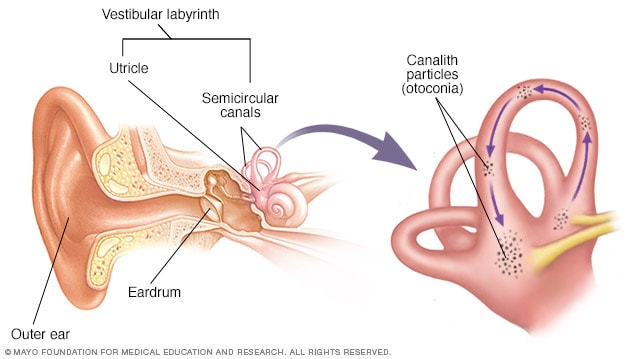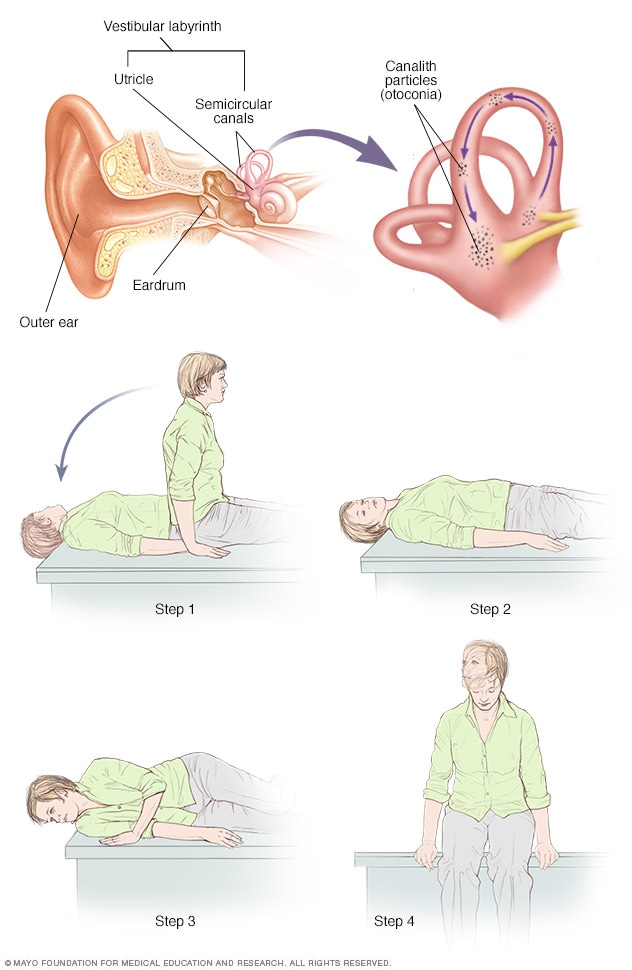Overview
The canalith repositioning procedure can help relieve benign paroxysmal positional vertigo (BPPV). BPPV is a condition that causes brief, but intense, feelings of dizziness and spinning. These sensations also are known as vertigo. They may occur when you move your head.
Vertigo usually comes from a problem with the part of the inner ear responsible for balance. BPPV occurs when tiny canalith particles, also called otoconia, in one part of the inner ear break loose and fall out of place. They often move into the semicircular canals of the inner ear. This can make you sensitive to movement and cause vertigo.
The canalith repositioning procedure can move these particles to a part of the ear where they won't cause dizziness. The procedure uses several simple head movements. It can be done in a health care provider's office. The procedure is usually effective. The procedure relieves vertigo in about 80% of people after one or two treatments. But the problem may happen again.
Products & Services
Why it's done
The inner ear and canalith repositioning

The inner ear and canalith repositioning
Vertigo is caused by a problem with the nerves and structures in the inner ear that control balance (vestibular labyrinth). Benign paroxysmal positional vertigo (BPPV) occurs when tiny canalith particles (otoconia) break loose and fall into the wrong part of the semicircular canals of the inner ear. The goal of the canalith repositioning procedure is to move the particles from the inner ear to a part of the ear where they won't cause problems (the utricle).
The canalith repositioning procedure is done to relieve symptoms of BPPV. The procedure moves the particles causing symptoms from a sensitive part of the ear — called the semicircular canals of the inner ear — to an area where they won't cause problems, called the utricle. Once there, these particles won't cause vertigo. The particles will likely dissolve or be reabsorbed by the body.
Risks
The canalith repositioning procedure has certain risks, such as:
- Neck or back injury
- Movement of the particles to a place that could continue to cause vertigo
- Side effects, such as nausea, dizziness and lightheadedness
Make sure you tell your health care provider about any medical conditions you have, such as a neck condition, a back condition or advanced rheumatoid arthritis, before getting the procedure. You may need to delay having the procedure.
How you prepare
There are no special preparations for the canalith repositioning procedure. Wear clothing that will allow you to move freely through each position.
What you can expect
During the procedure
Canalith repositioning procedure

Canalith repositioning procedure
The canalith repositioning procedure can treat benign paroxysmal positional vertigo (BPPV), which causes dizziness when you move your head. The procedure includes head positions that move the canalith particles (otoconia) in the inner ear that cause the dizziness to a part of the ear where they won't (the utricle).
The canalith repositioning procedure involves holding four positions for about 30 seconds each or until symptoms stop. You'll stay in each position about 30 seconds after your symptoms have ended. Your health care provider will watch your eyes for irregular movements during the procedure. The procedure may be repeated three or more times within a treatment session.
The canalith repositioning procedure includes these steps:
- You move from sitting to reclining with your head turned to the affected side by 45 degrees. Your health care provider will help extend your head over the edge of the table at a slight angle.
- You'll turn your head slowly to the other side by about 90 degrees.
- You'll roll onto your side. Your head should be slightly angled while you look down at the floor.
- You return carefully to a sitting position with your head centered and tilted down. You'll likely need to sit still for about 15 minutes.
After the procedure
After the procedure, follow your health care provider's instructions. Your care provider may teach you how to do the procedure so that you can do it at home if needed. You may need to do these exercises for many days before your symptoms go away.
Results
Nearly 80% of people who have the procedure experience relief. But if your symptoms come back, your health care provider can repeat the canalith repositioning procedure. The procedure may need to be done many times to help your symptoms. Talk to your health care provider if your symptoms don't improve.
Sept. 20, 2022